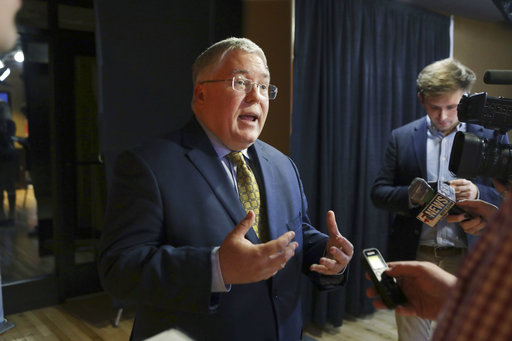A multi-state commission charged with ensuring water quality in the Ohio River will consider whether to eliminate its pollution control standards at its meeting on February 14. Thousands of people have expressed opposition during a public comment period, while others argue that the regulations are redundant and have no teeth.
The current debate started brewing five years ago, when Dayton Power and Light along with a handful of energy companies challenged the state of Ohio. They said state permits couldn’t use a standard set by the Ohio River Valley Sanitation Commission, known as ORSANCO, that limits the temperature of the companies’ waste discharges into the Ohio River. The companies pointed out that the state had never officially adopted the ORSANCO standards in Ohio law. And the companies won.
“It was a shock,” said ORSANCO commissioner Tom FitzGerald. He and others hadn’t realized that some states weren’t adopting the agreed-upon standards.
What is ORSANCO?

ORSANCO is a compact between the eight Ohio River states that dates back to 1948, before the federal Clean Water Act and before states had their own water quality standards.
Each of the eight states has two or three commissioners. Fitzgerald, who is an environmental lobbyist in Kentucky, is considered a federal commissioner on the ORSANCO board.
“I’m one of three federal commissioners that were appointed by President Obama,” he says. “I guess I’m a holdover.”
Through the decades, the water quality experts at ORSANCO have created rules and standards for all kinds of discharges into the river, like limits on sewage and pollutants such as benzene and mercury to protect aquatic life and human health.
Some States Adopted ORSANCO Standards, Others Didn’t
The 2014 Dayton Power and Light case brought to light an issue of disparity among states in the compact. Some, like Pennsylvania and Indiana, have adopted the ORSANCO standards, while others, like Ohio and Illinois, have not.
“Your technical people and your commissioners have been approving these standards for decades. Are you now telling me they’re suitable and appropriate for the river, but you’re not using them?” FitzGerald asks.
Fitzgerald says this disparity impacts water quality and creates an unfair playing field for industries in the different river states. For instance, states that have adopted ORSANCO regulations, like Pennsylvania, limit some mercury discharges into the Ohio River, while Illinois does not.
Toby Frevert, ORSANCO commissioner from Illinois, chairs its Pollution Control Standards Committee. He spent his career as manager of water pollution control at the Illinois EPA, and explains that his state has a Pollution Control Board that decides state regulations. ORSANCO has no legal authority.
“They don’t have the luxury of delegating that off to an interstate commission or anybody else,” Frevert says of the Illinois Pollution Control Board. “They have to adopt the regulations that the administrative agency is bound to operate by.”
States are required to work with the US EPA to meet federal water quality standards, so Frevert doesn’t think ORSANCO is needed as a pollution regulator any longer.
“In my opinion, ORSANCO’s a great organization – I love it,” he says. “But it’s really not designed or staffed to handle regulations in the modern era the way US EPA and the state environmental agencies are.”
“Not the Time to Signal a Retreat”
But one analysis by ORSANCO found 188 instances where it regulates pollution, and the U.S. EPA does not, and others where federal regulations are less stringent.
Tom FitzGerald, the federal ORSANCO commissioner in Kentucky, looks at the current rollback of federal environmental regulations.
“Even the Clean Water Act itself is in turmoil,” he says.
Fitzgerald wants ORSANCO protections to stay in place.
“This is not the time to signal a retreat from the maintenance of standards intended to protect the health of the public and the use of river,” he says.
Since last year, ORSANCO has been considering eliminating its pollution control standards. The agency received well over 5000 public comments on its proposal, most of them opposed to eliminating the standards.
The commissioners are scheduled to vote at their February 14 meeting, but many expect it will be delayed as they consider revisions.
This story was originally published by The Allegheny Front. The Allegheny Front is produced in Pittsburgh and reports on the environment. More at alleghenyfront.org.



